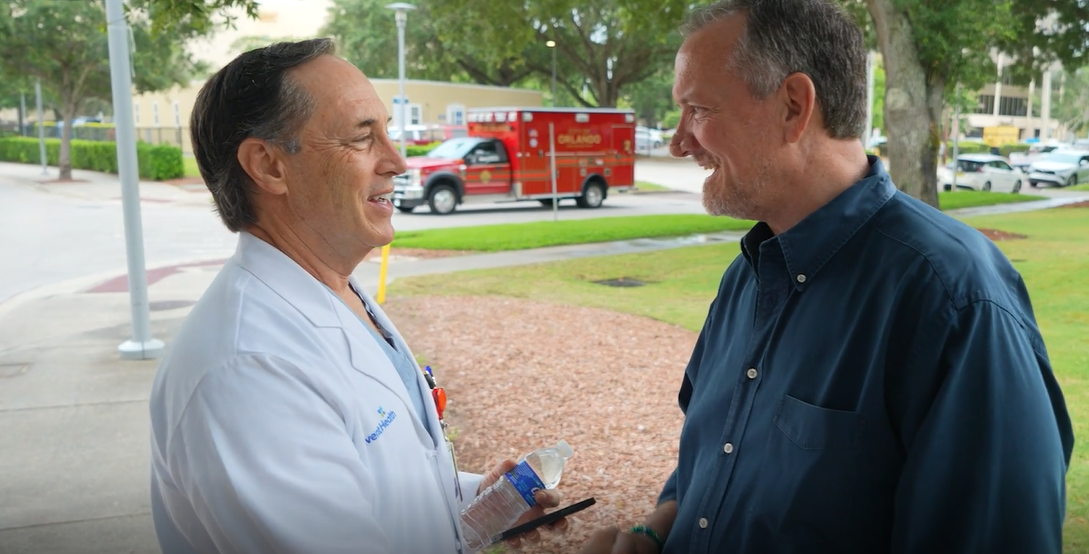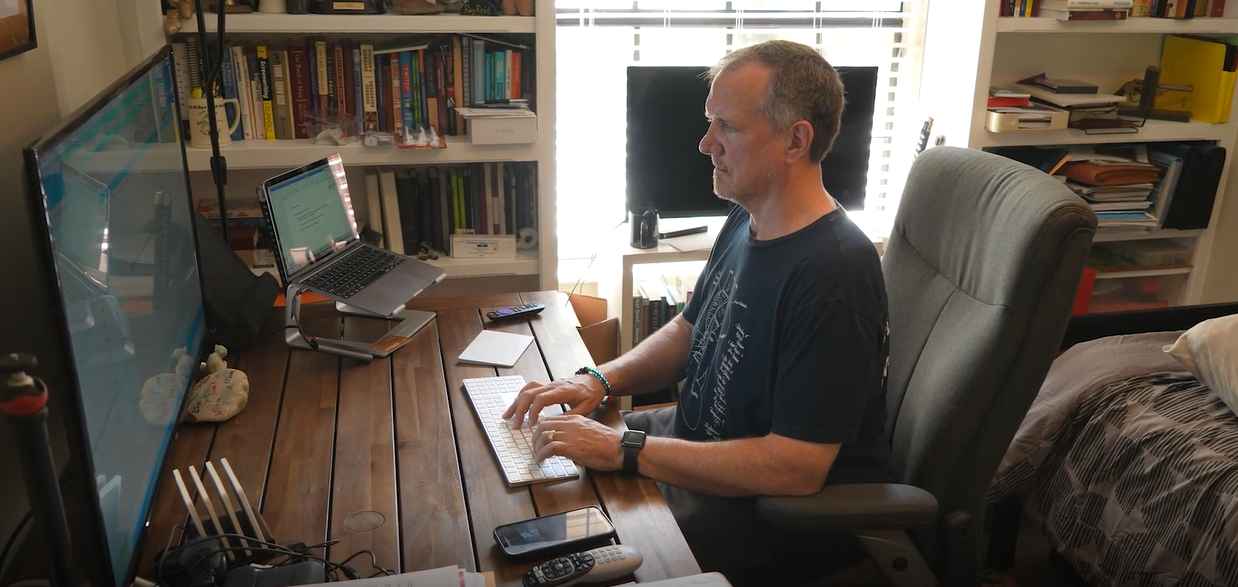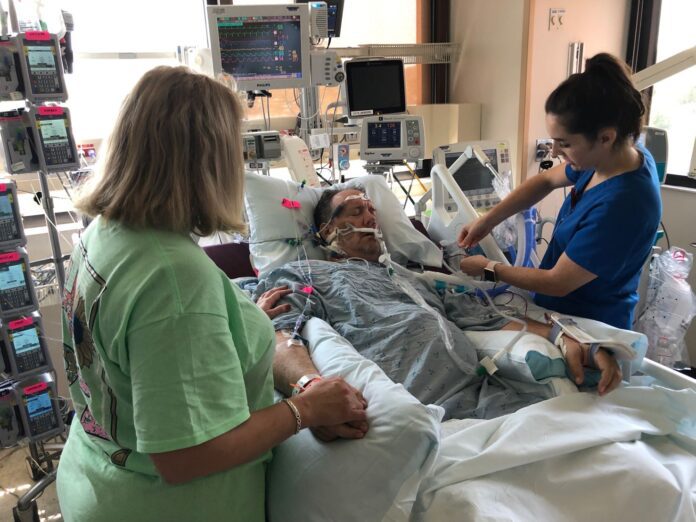Three years ago, Roy Reid of Longwood, Fla. experienced massive chest pains. These pains, he says, nearly scared him to death!
“I’m asleep one night and wake up at two in the morning and it feels like someone is punching a hole through my chest and just squeezing the life out of my heart,” Reid describes. He knew something was seriously wrong. “I woke up my wife and told her to take me to the ER.”
Unfortunately, things worsened. Reid, then 54, had a stroke on the way to the local hospital, AdventHealth Altamonte Springs ER, just north of Orlando. However, his unresponsive state may actually have helped medical professionals correctly identify the grim diagnosis: acute aortic dissection. In a way, Reid’s heart had exploded.

What is Aortic Dissection?
According to the American Heart Association, aortic dissection is a life-threatening condition in which a tear in the wall of the aorta – the major artery carrying blood out of the heart – allows blood to rush between the wall’s layers.
Signs and symptoms include:
- Sudden severe chest and/or upper back pain, often described as a tearing or ripping sensation, that spreads to the neck or down the back
- Sudden severe stomach pain
- Loss of consciousness
- Shortness of breath
- Symptoms similar to those of a stroke, including sudden vision problems, difficulty speaking and weakness on one side of the body
- Weak pulse in one arm or thigh compared to the other
- Leg pain/difficulty walking
Getting Immediate Help
Relatively uncommon, aortic dissection most often occurs in men who are in their 60s and 70s. Symptoms can mirror those of other diseases, thus leading to delays in diagnosis. However, when an aortic dissection is detected early and treated immediately, the chance of survival greatly improves.
In Reid’s case, once the aortic dissection was presumed, he was placed on a Flight 1 helicopter and flown to AdventHealth Orlando, a sister hospital better equipped to provide the necessary emergency surgery.

“It’s very important that you have an emergency room team that not only recognizes the signs and symptoms but then orders the appropriate tests, and then continues to keep the patient resuscitated while they are going to the operating room,” explained Dr. Kevin Accola, executive medical director of cardiovascular surgery at AdventHealth Orlando. “The clock is ticking at that point. If patients are operated on in the first few hours, their chances are much better than if they are operated on in 12 or 24 hours. Certainly, with an acute aortic dissection, when they are also having decreased blood flow to their head, and neck and other organs, it becomes imperative that they are treated quickly and appropriately.”
Reid’s surgery took six hours and, thankfully, the outcome was terrific. He survived and has gone on to thrive! Sadly, not all outcomes are as favorable; aortic dissection carries a high mortality. According to the National Institute of Health, at least 30% of patients die after reaching the emergency room; and even after surgery, the mortality rates vary from 20-30%.
Now, following his successful surgery, roughly a quarter of Reid’s heart is comprised of synthetic material. But it is intact and functioning well.
“About 25 percent is synthetic from the aortic valve to the Dacron graft material which replaces the natural/normal aortic tissue… and becomes the pathway for blood flow to the rest of the body and organs,” Dr. Accola tells AmeriDisability.
Reid, who enjoys working in the communications field, says his total inpatient time in the hospital post-surgery was a month-long. “For the first week following surgery, I was in an induced coma to help with the healing process,” he says. Then recovery included 12 weeks of cardiac rehab.
Still, another hurdle came. “I had a follow-up procedure nearly a year (February 2020) after the first surgery to repair (stent) the lower aorta, which suffered an aneurysm because of the damage from the dissection,” he tells AmeriDisability.

Keeping a Healthy Beat
Since the near-fatal cardiac incident, Reid has prioritized his heart health. He lost about 40 pounds, routinely exercises and even participates in 5K races (maintaining a brisk walking pace).
His medical team applauds his positive attitude. “Roy Reid is an inspiration for everyone,” Dr. Accola says. “Anyone who is overcoming medical circumstances, the way he has approached this, I think is a lesson well-learned.” Naturally, Reid thinks the accolades should be flipped to the medical professionals. He graciously counts each day since ER physicians and advanced care specialists saved his life.
“We’re on day 1,091 now,” Reid says. Surprising to many, Reid never wishes it were all a nightmare that he didn’t actually experience. “While I wouldn’t wish it on anybody, it’s the best thing that ever happened to me. It’s been three years, and I’ll keep counting each day because it’s a gift. It’s a story of mission, medicine and miracles… This second life is something special!”
What Could Happen After an “Exploding Heart” Event
In a study of aortic dissection patients treated at the Cleveland Clinic, researchers engaged roughly 300 people with an online survey to screen for post-traumatic stress disorder (PTSD). The Mayo Clinic describes PTSD as a mental health condition that’s triggered by a terrifying event — either experiencing it or witnessing it. Symptoms may include flashbacks, nightmares and severe anxiety, as well as uncontrollable thoughts about the event.
“Any type of event that is sudden onset, highly painful and life-threatening has the potential to cause PTSD,” said Donald Edmondson, director of Columbia University’s Center for Behavioral Cardiovascular Health in New York, who was not involved in the study. “But what’s unique and special about medical events like this is that unlike combat or sexual assault, where people can find a safe place where they’re not at risk, someone who’s had an aortic dissection or a heart attack or stroke can never get away from their heart (or brain).”

Reid acknowledges that he experienced such feelings. “Yes, there are several issues you confront coming out of that ordeal. I benefitted from counseling as part of my recovery,” he shares.
Should PTSD be suspected following a cardiac event or medical incident, it’s important to explore treatment options promptly, especially since high stress can increase the risk of a secondary cardiovascular event.






